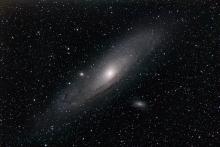Listen to today's episode of StarDate on the web the same day it airs in high-quality streaming audio without any extra ads or announcements. Choose a $8 one-month pass, or listen every day for a year for just $30.
You are here
Future Blast
The Andromeda galaxy is our nearest big galactic neighbor. In fact, it’s bigger than our own galaxy, the Milky Way. Despite its vastness, though, the last time anyone saw a supernova explode there was more than a century ago. But astronomers recently discovered a star in Andromeda that seems destined to explode — in a million years.
The star is a white dwarf — the small, dead core of a once-normal star. A white dwarf explodes if it gets too heavy — in particular, when it gets more than 1.4 times the mass of the Sun.
This white dwarf already becomes a nova at least once a year. A nova is a much less dramatic flare-up than a supernova. It doesn’t get as bright as a supernova, and it doesn’t destroy the star. But the white dwarf is already close to the critical mass of 1.4 Suns. As a companion star dumps more material onto it, the white dwarf is getting heavier. It should exceed the critical weight limit in less than a million years, and this periodic nova will become a supernova.
Actually, if this estimate is right, then the star has already exceeded the weight limit and exploded. We haven’t seen it yet because the Andromeda galaxy is two-and-a-half million light-years away, so its light takes two-and-a-half million years to reach us. So it’s possible that the star blasted itself apart more than a million years ago. Now, we just have to wait for its light to reach Earth, allowing us to see a supernova flare up in the Andromeda galaxy.
Script by Ken Croswell, Copyright 2017





